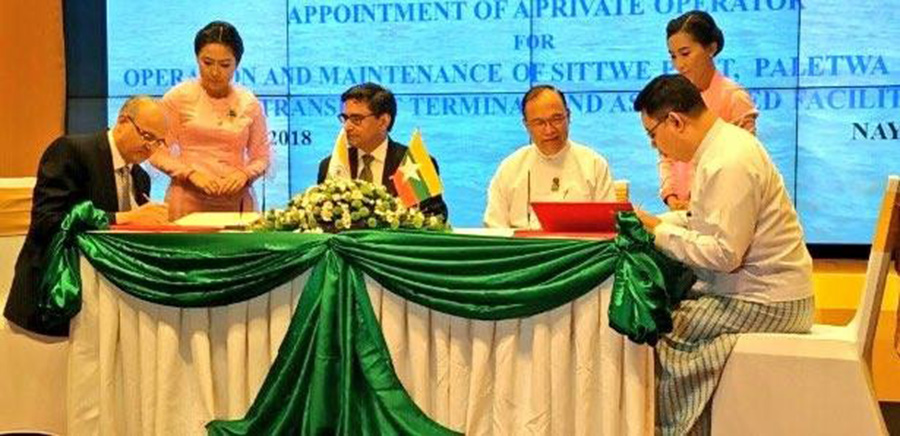YANGON—Myanmar signed a Memorandum of Understanding (MoU) early this week with India to appoint a private operator for Sittwe Port. The move is part of the Kaladan Multi Model Transit Transport Project under India’s ambitious Act East Policy.
According to the MoU, the private operator will manage the operation and maintenance of a deep-water port in Sittwe, the capital of Rakhine State on the Bay of Bengal, as well as the Paletwa Inland Water Terminal in Chin State and associated facilities that are part of the transport project.
A statement from the Indian Embassy described the MoU, signed during Indian Foreign Secretary Vijay Keshav Gokhale’s visit to Myanmar, as “a significant step in the implementation of India’s Act East Policy.” It said the agreement would boost connectivity between the two countries and promote regional development, particularly in Chin and Rakhine states.
The statement said, “It would also add to local infrastructure capacity and help in creating more job opportunities for the local people.”
India shares a 1,600-km-long border with Myanmar, whose strategic location between Southeast Asia and East Asia makes it important to New Delhi’s Act East Policy.
India adopted its “Look East” policy in 1991 to enhance economic and strategic relations with Southeast Asia in an effort to strengthen its role as a regional power, and to provide a counterweight to China’s influence in the region. Indian Prime Minister Narendra Modi carried the policy to the next level, renaming it the “Act East Policy.”
The ambitious policy aims to develop comprehensive, close ties in politics, economics and security through developing trade relations with the Mekong countries and other states surrounding China, according to the report “India’s Act East Policy Amid Myanmar’s Centre-Periphery Conflict” published in 2017 by India’s South Asian University. Myanmar serves as a crucial buffer state between China and India and also plays a crucial part in China’s ambitious Belt and Road Initiative (BRI). One component of the BRI, the China-backed Kyaukphyu Special Economic Zone, is 100 km south of the India-backed Sittwe Special Economic Zone. A railway network is planned between China’s Yunnan and Kyaukphyu to facilitate trade.

New Delhi has been making efforts to get transit access through Bangladesh to ship goods to India’s landlocked northeastern states. A key element of India’s Act East Policy, the Kaladan Multi-Modal Transit Transport Project—for which it signed a framework agreement with Myanmar in 2008—expects to open sea routes and a highway transport system to link the eastern Indian seaport of Kolkata with its landlocked northeastern state of Mizoram through Myanmar’s Rakhine and Chin states.
In Myanmar, the link will connect Sittwe seaport to Paletwa in Chin State via the Kaladan River route, and Paletwa to Mizoram State by road. The project includes 158 km of waterway on the Kaladan River from Sittwe to Paletwa in Myanmar and a 109-km road component from Paletwa to Zorinpui along the India-Myanmar border in Mizoram.
The project also aims to reduce the travel distance from Kolkata to Sittwe by about 1,328 km through the use of waterways, reducing by three or four days the time needed to transport goods through the narrow Siliguri corridor, also known as the “Chicken’s Neck.”
According to the Kaladan Movement, the Indian government expects the Kaladan project to increase economic linkages with Myanmar and the rest of Southeast Asia. The Kaladan Movement is an alliance of civil-society organizations concerned about the human-rights, social, economic and environmental impacts of the Kaladan project. The estimated expense of the entire project of $480 million is being provided through the Indian Ministry of External Affairs (MEA).
According to India media, the project is scheduled to be operational by 2019-20. The project is being implemented in four major phases. Phase 1 involves constructing jetties and a port facility in Sittwe to accommodate large cargo ships; Phase 2 involves dredging and widening stretches of the Kaladan River into a 160 km inland waterway transport system for cargo ships, including the construction of a port and transshipment terminal at Paletwa Town in Chin State; Phase 3 involves the construction of a 130-km two-lane highway from Paletwa Town to the Myanmar-India border crossing at Myeik Wa village; and Phase 4 will see the construction of a 100-km two-lane highway in Mizoram State from Lomasu to Lawngtlai. This will connect with the existing Indian National Highway and include the construction of a land customs station at Zorinpui in Mizoram.
Neither side has announced updates on estimated completion dates. According to Indian media, phases 1 and 2 were mostly completed between 2014 and 2016. Some projects have been halted due to the Rohingya crisis in Rakhine State, according to India media reports.
U Mg Mg Soe, an expert in the history of Rakhine and an observer of social, economic and political developments in the state, said that while Rakhine made international headlines due to the communal violence between local Buddhists and Rohingya Muslims in the north, the conflict shouldn’t impact the project due to its location several hundred miles to the south.
“The project will assist India to transport goods from Kolkata to its western states. We will only get service charges from the port,” U Mg Mg Soe said.
He said that if Myanmar wants to see real benefits from the project, the government needs to establish direct trade with the eastern and southern states of India.
During the visit, Foreign Secretary Gokhale said that “India values its relationship and close cooperation with a close neighbor like Myanmar and will continue to deepen its cooperation with it in the areas of connectively, security, people-to-people relations and economic and commercial cooperation,” according to the statement.
Under the Act East Policy, Myanmar and India opened two land-border crossing in August—at Tamu-Moreh in Manipur, northeastern India, and Rihkhawdar-Zowkhawtar in Mizoram—to facilitate closer trade and commercial ties.

















